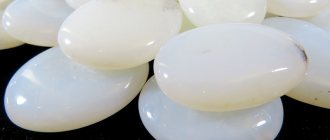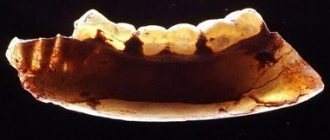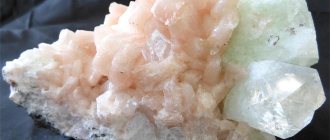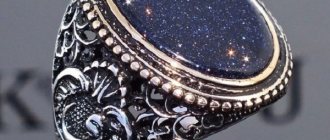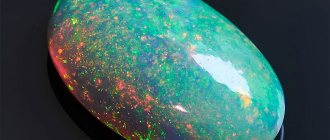What is synthetic opal?
Externally, synthetic opal is practically indistinguishable from natural opal. High-quality fakes have physical characteristics identical to the mineral, with some improved features.
The color palette of synthetic stones includes any possible shade. Tone is imparted by diffraction without the use of dyes.
In artificial gems there is an increased density and there is no water in the composition.
In addition, the breed has certain advantages over its natural counterpart:
- cheapness;
- bright, rich color;
- beautiful shine;
- resistance to external factors;
- hardness.
How the gem was created
Synthetic opal ring
Humanity learned to artificially reproduce opals back in ancient times. In Ancient Rome, cheap analogues of the mineral were made from hot glass. To do this, it was heated and sharply cooled to simulate microcracks and inclusions characteristic of the stone.
The patent for the production of artificial opals was first acquired by mineralogists from Australia A. Gaskin and P. Darré in 1964. At the first stage of the synthesis, scientists produced silica spheres of the required size. Since the balls formed under artificial conditions contained more water than in natural opal, the next step was dehydration and gluing of the spheres using heating.
Around the same time, scientists in Delaware succeeded in producing spherical silica particles with an ideal diameter of 0.1 microns. In the intermediate layer between the balls, the bright colors of noble natural opal were observed. Addition of hydrochloric acid to the solution resulted in the formation of solid particles with a full spectrum of colors. This is how the first lab-grown opal appeared, with the play of colors characteristic of the rock.
The synthesis process was improved and was later supplemented by the use of organic silicon compounds with the addition of ammonia. Heating technology continued to be used to compact the balls in order to reduce the voids between them.
Synthetic opal
And in 1973, the Swiss organization of Pierre Gilson began producing high-quality synthetic gems in a wide variety of variations. Gems are in no way inferior to natural ones and even have opalescence. Gilson samples are characterized by a certain porosity. The stones become transparent only after immersion in chloroform. The color of the stones is close to natural samples of black and milky white. The patterns and opalescence are also almost identical to the originals.
There are four leading manufacturers in the world:
- The Japanese company Kyotsera, famous for opals made from various layers, impregnated with transparent colorless rubber.
- Slocum, which produces rock from a special glass with a velvety shine.
- Gilson's company. Creates stones from layers of natural opal with an artificial base.
- Inamori Corporation, which reproduces a breed almost identical to the natural one in chemical characteristics.
These organizations produce the best quality gems. Only they use substances contained in natural opal in production.
Artificial gems are also produced in Russia and China. But they make them from polymers and glass.
Imitation black precious opal
True noble black opal is mined from the only deposit in the world in Australia. Its extraction is very expensive, its volumes are relatively small.
Accordingly, products made from natural black opal are very expensive - from thousands to tens of thousands of dollars per carat. It is not surprising that a huge market has arisen for products imitating noble black opal. Some types of imitations, having tens of times less price, turn out to be very similar to natural stones. In the context of this article, the word "imitation" is used in a broad sense - i.e. everything that looks like a real natural stone, but in fact is not one.
First, let's look at options containing natural noble opal.
Doublets.
A thin slice of natural opal is glued onto a backing of less valuable material. At best, for less valuable opal from the same deposit, at worst, any other materials, even plastic. The top of the doublet can be either flat or slightly convex. In a doublet, the top is real precious opal, so for the purist who doesn't have a very deep wallet, this is probably the best option for a fake. A doublet can be diagnosed by the presence of a seam, but if the stone is set, the seam may not be visible.
Triplet.
Consists of three layers. Essentially, this is a flat doublet with a plate of transparent material, such as rock crystal, glued on top. This top has a dual function - firstly, it protects the noble layer from mechanical damage and, secondly, when properly cut as a cabochon, it creates the illusion of a real “thick” opal. However, there is a possibility that the adhesive layer will become cloudy over time and the product will lose its original beauty. The triplet can be recognized by the presence of glues, as well as by the transparent top, if you examine the stone from the side in the light. Doublets and triplets can be tens and hundreds of times cheaper than whole opals of similar size and quality and are very popular on the market. Often the noble layer covers several opalizing fields, which makes it possible to increase the size of the product.
Refined opal
Since black opal is the most valuable variety of opal, various methods have been developed to treat light opals to make them darker. One method, called “carbonization,” involves heating the opal in a sugar solution and then treating it with sulfuric acid. Refining can indeed create the appearance of a more valuable opal. It’s good if the seller honestly states that his opals have been refined, but scammers are also trying to make money in this field.
Fortunately, refined opals are easy to distinguish from natural ones. The treatment makes polishing difficult and therefore the surface of carbonized opals has the appearance of so-called French enamel. There are also ways to enhance color using plastic and resin impregnation. Such impregnation, in fact, even improves the consumer qualities of the product, making it more resistant to environmental influences. But it's still a fake. You can distinguish the presence of organics by smell, for example, by carefully touching the surface with a hot needle, but a more reliable way to determine the presence of organics is an infrared spectrometer.
Below is a brief description of imitations without the use of natural opal
Synthetic black Gilson opals.
This is perhaps the most expensive method of imitation. Synthetic opals created using the Gilson method even surpass many natural precious opals in brightness and size of color flashes. In their composition they are very close to them. Just like natural ones, they consist of ordered silica globules of a certain size and, accordingly, have the same origin of color flashes. The only difference is that the space between the globules in natural opal is filled with water, while in artificial opals it is filled with a cementing substance, although the latter fact is, in a sense, beneficial, making synthetic opals more durable. The main distinguishing features of synthetics are shorter phosphorescence in UV rays, a columnar internal structure, expressed in a peculiar surface pattern like lizard skin and in the form of vertical columns in section, clearly visible, for example, in beads.
The artificial origin is also indicated by the noticeable orderliness and zonality of the arrangement of color spots, and even their excessive brightness and the presence of such rare and valuable colors as red. Synthetic black opals are not cheap - around $100 per carat or more, but in any case this is not commensurate with the price of natural stones of similar quality and size.
Slocum Stones
Or as they are also called, “Slocum glass” was developed by the American John Slocum to imitate precious opal. It is sodium glass with calcium and magnesium additives. As a result of many years of expensive experiments, he managed to achieve excellent results. These stones can also look very similar to natural opal, but an experienced eye will recognize them with ease.
The character of the color flashes in Slocum stones is characterized by a lack of silkiness. Their shape is often triangular and in their mass they are more like a scattering of colored sparkles. Diffraction in Slocum stones is created not by ordered globules as in natural opal, but by microscopic layers located at regular intervals.
Imitations based on shiny scales
There is also a large number of more primitive fakes, when various shiny multi-colored scales are mixed into glass or plastic. Such products can also have a nice appearance and have their rightful place in the costume jewelry market, but the color effect of such imitations has nothing to do with the nature of these effects in natural opals and is easily recognized.
Every stone has its place
If we exclude fraud, when they try to sell a cheaper fake under the guise of an expensive natural stone, then all of these imitations listed have their own value and their own buyer. And the matter may not only be the presence or absence of a large amount of money. Someone may want to have both a natural noble opal, which he will care for and cherish, and one of the imitations, which can be worn for any outing “in public” without fear of damage or loss, and which will look no less stunning, but at the same time, few people around will guess what it really is.
Properties of synthetic Gilson opals
Gilson opal The
Gilson company produces opals of all categories: from rare black to crystalline white opal, which, according to many gemologists, is the most refined. The laboratory conditions in which it is produced are identical to those in which opal is formed in nature. This process takes 14 to 18 months and the colors are natural and appear as in natural opal by diffraction rather than by pigments.
Unlike its natural counterpart, synthetic opal is denser, it does not contain water and is not prone to cracking. Natural opals contain up to 10% water.
The fact today is that synthetic opals are affordable and come in a wide variety of variations. Many people believe that their beauty, hardness and insensitivity to heat are their undoubted advantages.
Doublet, triplet and solid opal
Caring for opals is not difficult. In fact, all you need is a responsible approach and sufficient knowledge. To decide on the method of care, you need to understand what type of opal you own.
Classification involves division into three main categories:
- Doublet. It consists of two layers - a plate of natural opal and a black backing to which it is attached. This design allows you to improve the color of the stone.
- Triplet . This type of opal is similar to a doublet, the only difference is that there is a third transparent layer of quartz or glass, which provides protection and helps create a perfect round shape.
- Solid opal . It is a polished and faceted natural opal without any auxiliary layers.
Synthetic Slocum Stones
Slocum Opals
The American John Slocum was able to successfully imitate an opal stone. For many years he spent a lot of money on experiments with silicate materials, and his work was crowned with success. At first, Slocum wanted to create an artificial gem, but in the end he invented a special glass. It has a variety of shades, but is practically devoid of water, which means it is much stronger than natural opal.
To the eye, a Slocum opal is almost impossible to distinguish from a real stone. The nuances are visible under high magnification: iridescent colored spots in the imitation look like scattering or triangles, while in a natural crystal they are flat and have a velvety shine. All Slocum stones are different, as it is impossible to predict the color of the glass when it is formed.
Russian synthetic opals
Russian synthetic opals
Scientists from the Institute of Solid State Physics of the Russian Academy of Sciences, located in the science city of Chernogolovka near Moscow, have developed a unique technology for producing synthetic opals. With its help, you can not only synthesize opals, albeit very beautiful ones, but also create opal matrices with a predetermined nanostructure, opening the way to materials for optoelectronics, magnetic recording systems and other fields of science and technology.
The basis of the new technology is the production of tiny, ranging in size from tens of nanometers to several thousand nanometers, beads of silicon dioxide. By changing the size of the balls, you can influence which wavelength of light the opal will absorb and which wavelength it will reflect, including in the visible region of the spectrum.
Which opal to choose: natural or synthetic?
Synthetic opal jewelry set
The final decision on choosing natural or synthetic opal is made by everyone at their own discretion, depending on their goals, requirements and capabilities. If you want to enjoy wearing a natural stone with an unusual play of colors, amazing magical and healing powers, powerful energy and an individual appearance, you need natural opal. The price is steep, but the stone and jewelry with it are worth it.
If you don’t believe in the magic of minerals, don’t think about energy, and don’t understand the intricacies of gemology, imitation opal in a beautiful frame is a justified decision in every sense. The main thing is to choose jewelry at an adequate price from a manufacturer who does not hide the fact that imitation is used and does not require you to pay the same amount for it as for natural opal.
Jewelry with synthetic opal
Synthetic opal jewelry
High-quality imitation is a good solution for those who love jewelry with opal, but cannot afford to buy a natural mineral.
Combining jewelry with artificial stone is not difficult because of the variety of colors in which they can be made.
Synthesized opal is extremely rarely set with precious metals.
More often these are light bracelets or other types of jewelry.
You can wear the product with any outfit. The breed will never look pretentious or inharmonious. Jewelry goes well with everyday wear.
Caring for Your Opal
Solid opals are quite fragile. They are equivalent in hardness to glass, which is about 6.5 on the Mohs scale. Therefore, to prevent the stone from being damaged, it is extremely important to treat it with care. Be sure to remove jewelry with opal when there is an increased likelihood of breaking or scratching it, for example, during gardening work, when rearranging furniture, etc.
In fact, the most valuable specimens contain 5-6% water. Consequently, they can crack if the air is too dry and there are sudden changes in temperature. Therefore, it is necessary to avoid such conditions during wearing and storage, for example, not being near boiling water or not keeping the opal in bank vaults where the humidity level is zero.
Many people believe that it is strictly contraindicated to wet solid opals, but this only applies to doublets and triplets. Solid opals are completely unaffected by moisture.
Caring for doublets and triplets differs compared to solid opals. This is due to the presence of several layers connected using a special glue. Prolonged exposure to water will eventually cause delamination and liquid penetration into the stone. As a result, the gem becomes cloudy and gray. But this does not mean at all that it will deteriorate if one day you forget to take off jewelry with such an opal while taking a shower or if you get caught in heavy rain. Negative consequences will appear only in case of prolonged exposure to water on a doublet or triplet.
Opal cleaning
Solid opal requires extremely careful cleaning. Use a gentle detergent, warm water and a soft toothbrush or cloth. Avoid bleaches, chemicals and harsh cleaning mixtures. Doublets and triplets can be wiped with a damp, non-harsh material using a mild detergent, but should never be soaked or completely immersed in water.
Solid opal prepared for cutting
Never allow your opal jewelry to be ultrasonically cleaned. Intense vibrations can cause a solid opal to split and water to penetrate into doublets and triplets.
If your stone has lost its former shine or is scratched, contact a professional cutter . Small cracks and abrasions on the gem, which may appear after many years of wear, lead to a deterioration in the shine of its surface. Consequently, the stone loses its original shine and takes on a dull appearance. Professional polishing will give this opal new life. The technician will also check the mounting for damage and the reliability of the frame.
Product prices
Rings artificial opal blue
Natural opal is several times more expensive than artificial opal. The cheapness of the stone is another advantage over its natural counterpart. Artificial stone jewelry can be purchased for about $10.
Making products using synthesized stone makes them affordable, and customers are satisfied with the quality and appearance of the reproduced opal.
A noble imitation - synthesized opal - is a justified solution for those who love beautiful jewelry with opal, but cannot afford to buy a natural original.
The only drawback of artificial stone is the lack of magical and healing properties.
Ennoblement
Artificial minerals are available for sale, but refined natural stone can also be purchased. Precious ones, especially black nuggets, are very rare, so imitation opal is becoming popular.
So-called doublets are stones on sale, the upper part of which is a transparent structure, and the lower part is a glued dark base. Thus, the appearance of synthetic opal is as close as possible to natural. If you look at the product in profile, you can see the border between the two layers. The cost of such jewelry is several times lower than the real thing.
Triplet technologies involve attaching a transparent dome to the base. An additional method is smoke impregnation. Its particles are retained inside and give the product greater brightness.
Refined artificial opal is more expensive than its ordinary imitation. Sellers can inform about the method of making the stone, its composition of two or three parts, but at the same time hide the fact of coloring. It is worth paying attention to the peculiarity of the product that its top, real and precious layer is not deep at all.
How to care for stone
Jewelry with unnatural stone is easy to handle and very durable. Therefore, there will be few rules for caring for it:
- Clean the product with soapy water whenever it becomes dirty. It’s not scary if you use soap and a toothbrush, but it’s better not to overdo it.
- The only reason opal should be stored separately from other stones is because they can scratch natural minerals.
- But try to avoid mechanical impacts on the breed. Even a synthesized gem can crack or chip.
A variety of imitation opal: doublets and triplets
Opal doublet blue
A common type of counterfeit opal on the jewelry market are doublets. Although this is only half an imitation. This product consists of an inexpensive dark stone (usually onyx) and a plate of natural opal, which is glued on top. As a rule, black opals are imitated in this way.
Triplets consist of three components. First, an opal plate is glued onto a dark substrate made of another stone, and then a transparent dome made of another material, most often quartz glass, is glued on top. This product costs much less than natural opal.
To fasten the parts, a durable epoxy adhesive is used that is not exposed to water, solvents and acids. However, doublets and triplets cannot be kept in water for a long time, since it penetrates into the space between the glued parts and eventually destroys them.
Types of imitations: how opal is faked
There are several ways to counterfeit a gemstone. Various materials are used, including natural ones. The most common types of imitations:
- glass;
- plastic;
- doublets and triplets;
- synthetic analogues;
- base opals.
Let's take a closer look at each of the listed options.
Glass and plastic fakes
Glass began to be used to replace rare gems back in ancient times. This is one of the simplest methods of imitation. First, the material is heated, then sharply cooled and the microcavities are filled with impurities.
The process of making plastic “stones” is also simple. Plastic is generally easy to process, which is confirmed by the low cost of products made from it.
Compared to real opal, synthetic material has a higher refractive index - up to 1.50 versus a maximum of 1.45 for its competitor.
But in general, both plastic and glass copies are significantly inferior in beauty to genuine samples.
Treated and synthetic opals
Not all opals are suitable for use in the jewelry industry; jewelry is encrusted only with specimens of the highest quality. They are called noble. Fraudsters often try to artificially inflate the value of base minerals. Thermal and chemical processing methods are used. After such refining, the inconspicuous opal becomes brighter in color and degree of luminescence. Often such stones are distinguished by their variegated colors. Bright pink, purple and acid yellow tones are rarely found in natural minerals, but often found in fake ones. According to the chemical formula, such gems do not differ from precious opals, and yet they are fake.
The same is true with synthetic raw materials created in the laboratory. Its composition is identical to rock. But the structure of the laboratory analogue is denser and has fewer pores. This is reflected in the appearance of the stone - laboratory samples look a little different. They are inferior to the creations of nature in the quality of opalescence and light play. Synthetic gems also have a slightly “scaly” structure, which is clearly visible when magnified under a microscope or magnifying glass.
Doublets and triplets
These are two- and three-layer fakes made using waste from the jewelry industry. Many opals crumble during mining and processing; they are not suitable as solid inserts. But enterprising people have learned not to waste valuable raw materials. The waste is used to make plates that contain the benefits of the mineral that gave birth to them (pattern, color, glow). An opal plate is placed on a dark base. The doublet is ready.
The triplet is distinguished by the fact that it also has a top layer – quartz glass. It favorably emphasizes the patterns on the plate and enhances opalescence
Many of these imitations look even more beautiful than the original. Therefore, not only scammers, but also prestigious jewelry houses are engaged in the production of triplets. The difference is that in the second case the buyer is warned about the fraud, but in the first case they are trying to deceive. You shouldn't be afraid of this. Noble opal is one of the most difficult stones to artificially recreate. If you know what to look for, the substitution can easily be exposed.
How to distinguish natural opal from synthetic one
Artificial opal pendant
Synthetic opals, created by skilled craftsmen, are outwardly indistinguishable from natural gems, so there are often cases of deception of buyers by unscrupulous sellers. In some cases, imitation can be determined by eye, knowing the features of the appearance and structure of the mineral. However, manufacturing technologies do not stand still, and sometimes, in order to identify a fake, it is necessary to conduct a gemological examination.
There are a number of ways to determine the authenticity of a stone, allowing you to avoid purchasing a fake at the price of natural opal. You can check the origin of a precious item using the methods below.
- Does the stone stick or not ? One of the most original ways to verify the authenticity of a mineral is to “lick” the stone. To determine the natural origin of the gem, it is applied to the tip of the tongue. The imitation opal will stick to the tongue for a couple of seconds, but this will not happen with a natural specimen. It is unlikely that it will be possible to use the verification method in a store, so the method is only suitable for determining the origin of a stone at home.
- Pay attention to the pattern . Natural opals are distinguished by the play of light and unique, non-repeating patterns on the surface. The stone will flicker and “play” in the rays of the sun, while the color should remain uniform. You can recognize an artificial mineral grown in a laboratory by carefully examining it. If the patterns are the same or repeated, and the brightness of the background color changes, then it is an imitation and not a real gem.
- How to recognize doublets and triplets . Artificial opals created by refining have “seams” in their structure. These are zones for gluing elements of natural stone and iron base. If you turn the fake on its side, then, looking closely, you can see thin stripes - the junction of the films.
- Transparency test . You can distinguish natural opal from artificially grown opal by assessing the purity and transparency of the stone. A real gem should be translucent or completely transparent, especially if the color is milky white. If the opal has a dark-colored backing visible in the light, then the product is made of synthetic materials. The origin of the mineral is also verified using daylight. The rays passing through the stone are refracted and color the hand in different shades, but in the case of imitation there will be no such effect.
- Unnatural colors . Growing synthetic stones makes it possible to paint the mineral in different colors of any saturation and shade, but the palette of real opals cannot boast of such variety. You can distinguish a natural insert from a fake by its unnaturally bright color, for example, if the specimen is richly blue, green or pink.
- Overflows and bubbles . Natural stone stands out with soft tints and radiant shimmer in daylight. Synthetic opals have a more obvious zonation of color - sharp transitions of shades are visible on the surface of the gem, which is a sign of a fake. Upon closer examination of the imitation under a magnifying glass, you can see round air bubbles - microcracks formed during the manufacturing process of the fake. In a real opal there should not be such bubbles.
- Product price . Due to its rarity and beauty, natural opal is expensive. The average price is the same as that of gold, and even higher for individual pieces. You can identify a fake by finding out the cost of the product, especially for black opals. This species is rare, so its price is high, and coal-black stones are not sold in ordinary stores. At special auctions, the cost of dark copies starts from $2,000.
5 / 5 ( 9 votes)
Artificial imitations of opal: how to distinguish them from natural ones
Laboratory-grown opal is not fake. This is a high-quality imitation, as close as possible in appearance and properties to natural stone. The price of the mineral is lower than the cost of its natural analogue and this is the main advantageous difference. In all other respects, synthetic opal is almost as good as natural opal, and in some areas (for example, strength and durability) it is even superior.
The situation is different with fake minerals. They are not grown in special laboratories, and no attempt is made to make them as similar to natural opals as possible in terms of quality characteristics. The only challenge when making fake stones is to achieve a visual resemblance to opal with minimal creation costs.
In jewelry, fake opals are often used instead of opal:
- fused glass;
- artificially refined minerals;
- triplets and doublets.
Let's look at the main fake breeds.
- Fused glass with pigments. The stone is visually very similar to natural opal. It will be difficult for non-specialists in the field of gemology to distinguish a fake. To understand that this is an imitation, it is worth examining the stone in the sun. Natural opal beautifully refracts light, painting the palm with a rainbow scattering. Fake glass can't do that. Another feature of natural opal is its natural pattern. It is unique and will not be repeated. Geometrically correct patterns with clear colored boundaries indicate a fake.
- If you look at a glass stone under a microscope, you can see air bubbles inside the cavity. There are no such defects in natural opal. Air bubbles form when heated at high temperatures followed by instantaneous cooling. Air in the cavity of the stone is direct evidence of fake glass.
- Another example of fake opal is the national team. What does composite mean? We are talking about artificial stones based on several layers. Depending on the number of layers, minerals are called doublets or triplets. The first are partially natural processed opal on an iron backing. A triplet is a combination of a base, an opal body and a transparent “cap”. Doublets and triplets are much cheaper than natural opals. In cross-section, it is easy to trace their layers; in the sun they are not transparent and are not able to shimmer beautifully, refracting light.
Whether treated stones should be classified as fakes is a controversial issue. We are not talking about glass imitations or multi-layered artificial minerals. Refined rocks are natural opals rejected by production, improved with the help of smoke impregnation and synthetic pigments. The desired effect is achieved due to the porous structure of the rock.
Depending on the defects, the stone is impregnated with smoke, in this way expensive black Ethiopian opals are obtained, painted with blue, pink and green pigments, passing them off as natural originals.
